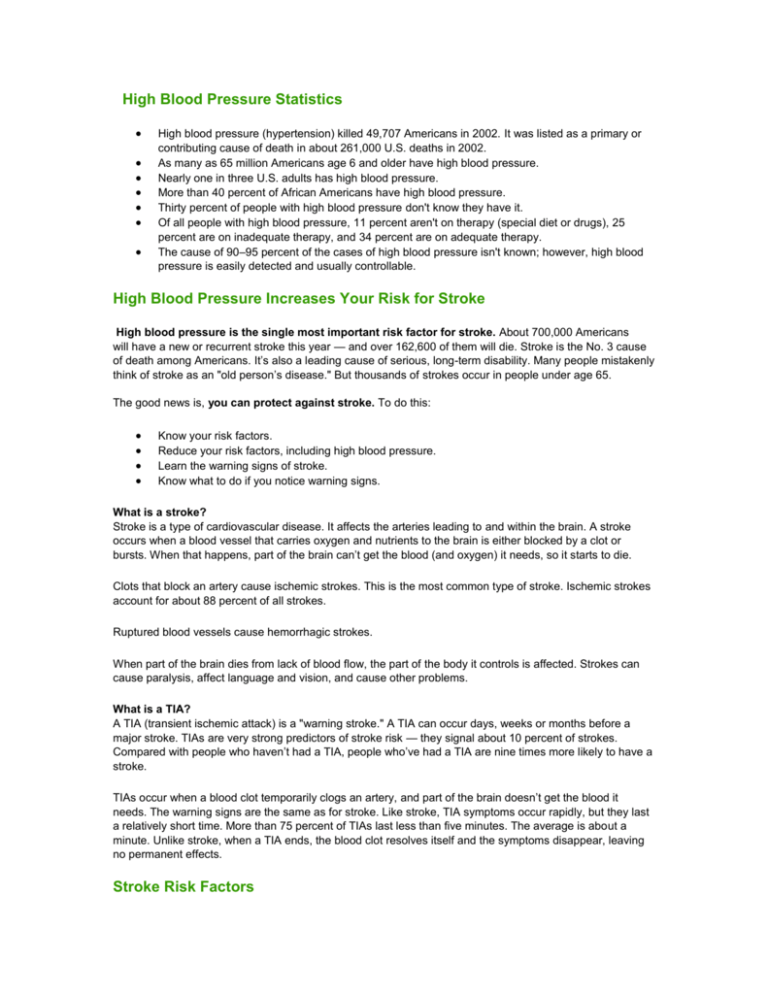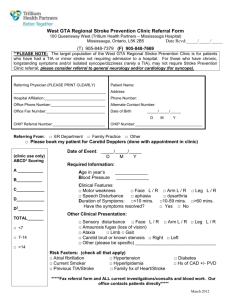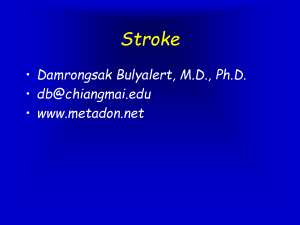High Blood Pressure Statistics
advertisement

High Blood Pressure Statistics High blood pressure (hypertension) killed 49,707 Americans in 2002. It was listed as a primary or contributing cause of death in about 261,000 U.S. deaths in 2002. As many as 65 million Americans age 6 and older have high blood pressure. Nearly one in three U.S. adults has high blood pressure. More than 40 percent of African Americans have high blood pressure. Thirty percent of people with high blood pressure don't know they have it. Of all people with high blood pressure, 11 percent aren't on therapy (special diet or drugs), 25 percent are on inadequate therapy, and 34 percent are on adequate therapy. The cause of 90–95 percent of the cases of high blood pressure isn't known; however, high blood pressure is easily detected and usually controllable. High Blood Pressure Increases Your Risk for Stroke High blood pressure is the single most important risk factor for stroke. About 700,000 Americans will have a new or recurrent stroke this year — and over 162,600 of them will die. Stroke is the No. 3 cause of death among Americans. It’s also a leading cause of serious, long-term disability. Many people mistakenly think of stroke as an "old person’s disease." But thousands of strokes occur in people under age 65. The good news is, you can protect against stroke. To do this: Know your risk factors. Reduce your risk factors, including high blood pressure. Learn the warning signs of stroke. Know what to do if you notice warning signs. What is a stroke? Stroke is a type of cardiovascular disease. It affects the arteries leading to and within the brain. A stroke occurs when a blood vessel that carries oxygen and nutrients to the brain is either blocked by a clot or bursts. When that happens, part of the brain can’t get the blood (and oxygen) it needs, so it starts to die. Clots that block an artery cause ischemic strokes. This is the most common type of stroke. Ischemic strokes account for about 88 percent of all strokes. Ruptured blood vessels cause hemorrhagic strokes. When part of the brain dies from lack of blood flow, the part of the body it controls is affected. Strokes can cause paralysis, affect language and vision, and cause other problems. What is a TIA? A TIA (transient ischemic attack) is a "warning stroke." A TIA can occur days, weeks or months before a major stroke. TIAs are very strong predictors of stroke risk — they signal about 10 percent of strokes. Compared with people who haven’t had a TIA, people who’ve had a TIA are nine times more likely to have a stroke. TIAs occur when a blood clot temporarily clogs an artery, and part of the brain doesn’t get the blood it needs. The warning signs are the same as for stroke. Like stroke, TIA symptoms occur rapidly, but they last a relatively short time. More than 75 percent of TIAs last less than five minutes. The average is about a minute. Unlike stroke, when a TIA ends, the blood clot resolves itself and the symptoms disappear, leaving no permanent effects. Stroke Risk Factors Risk factors you can change, treat or control High blood pressure — This is the single most important risk factor for stroke. Know your blood pressure and have it checked at least once every two years. It should be lower than 120/80 mm Hg. Diabetes mellitus — Diabetes is treatable, but having it still increases a person’s risk of stroke. People with diabetes often also have high blood pressure and are overweight, increasing their stroke risk even more. If you have diabetes, work closely with your doctor to manage it. Heart disease — People with heart disease have a higher risk for stroke. Atrial fibrillation, which causes an irregular heartbeat, is a significant risk factor for stroke. Heart attack is the major cause of death among stroke survivors. TIAs — A TIA (transient ischemic attack) is a "mini" stroke that lasts a short time and goes away without causing permanent damage. Recognizing and treating TIAs can reduce your risk of a major stroke. It’s very important to recognize the warning signs of a TIA or stroke. Call 9-1-1 or get medical attention immediately if they occur. Carotid artery disease — The carotid arteries in your neck supply blood to your brain. A carotid artery narrowed by a fatty buildup of plaque (atherosclerosis) may become blocked by a blood clot, causing a stroke. Risk factors requiring a lifestyle change Many people don’t realize that stroke is usually predictable and often preventable. Here are the risk factors you can modify by the personal choices you make each day: Tobacco use — Don't use tobacco in any form. Physical inactivity and obesity — Be active and reach and maintain a healthy body weight. Excessive alcohol intake — Drink only in moderation or not at all. (no more than one drink a day for women or two drinks a day for men). Illegal drug use — Don't use illegal drugs. Risk factors you can't change These are the risk factors that you can’t do anything about: Increasing age — The older you get, the greater your risk. Heredity and race — If close blood relatives have had strokes, you're at higher risk. And members of certain racial groups, such as African Americans, have a higher risk. Prior stroke — If you've had a stroke, you have a greater chance of having another one. Remember! Know the warning signs! Stroke is a medical emergency! Respond quickly and call 9-1-1! Don't ignore the warning signs of stroke, even if they go away! Knowing these warning signs may help you save your life or the life of someone you love.







